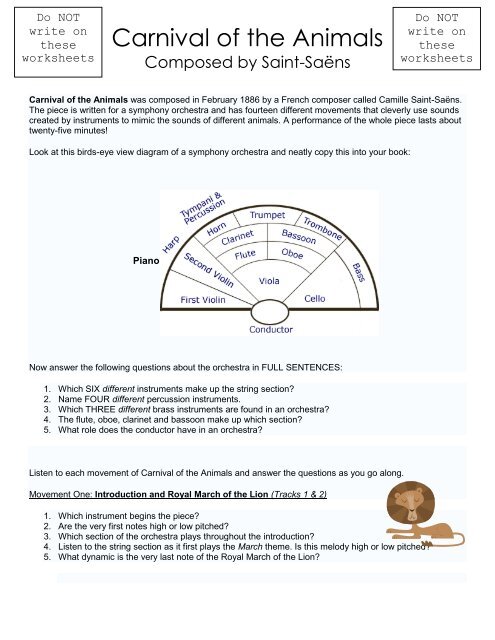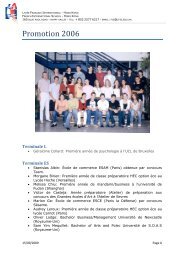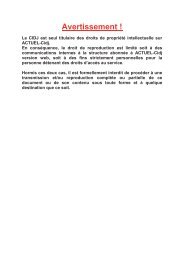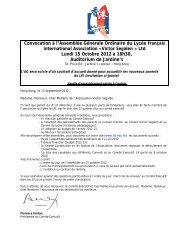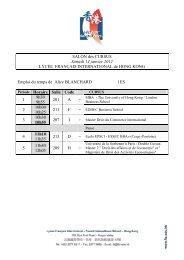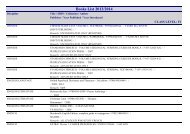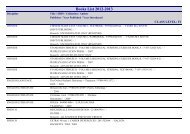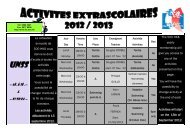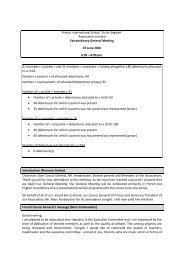Composed by Saint-Saëns
Composed by Saint-Saëns
Composed by Saint-Saëns
Create successful ePaper yourself
Turn your PDF publications into a flip-book with our unique Google optimized e-Paper software.
Do NOT<br />
write on<br />
these<br />
worksheets<br />
Carnival of the Animals<br />
<strong>Composed</strong> <strong>by</strong> <strong>Saint</strong>-Saëns<br />
Do NOT<br />
write on<br />
these<br />
worksheets<br />
Carnival of the Animals was composed in February 1886 <strong>by</strong> a French composer called Camille <strong>Saint</strong>-Saëns.<br />
The piece is written for a symphony orchestra and has fourteen different movements that cleverly use sounds<br />
created <strong>by</strong> instruments to mimic the sounds of different animals. A performance of the whole piece lasts about<br />
twenty-five minutes!<br />
Look at this birds-eye view diagram of a symphony orchestra and neatly copy this into your book:<br />
Piano<br />
Now answer the following questions about the orchestra in FULL SENTENCES:<br />
1. Which SIX different instruments make up the string section<br />
2. Name FOUR different percussion instruments.<br />
3. Which THREE different brass instruments are found in an orchestra<br />
4. The flute, oboe, clarinet and bassoon make up which section<br />
5. What role does the conductor have in an orchestra<br />
Listen to each movement of Carnival of the Animals and answer the questions as you go along.<br />
Movement One: Introduction and Royal March of the Lion (Tracks 1 & 2)<br />
1. Which instrument begins the piece<br />
2. Are the very first notes high or low pitched<br />
3. Which section of the orchestra plays throughout the introduction<br />
4. Listen to the string section as it first plays the March theme. Is this melody high or low pitched<br />
5. What dynamic is the very last note of the Royal March of the Lion
Movement Two: Hens and Cocks (Track 3)<br />
1. In this movement <strong>Saint</strong>-Saëns composes music that sounds like chickens pecking at grain. How does<br />
he achieve this<br />
a) By using long, sustained, low-pitched brass notes<br />
b) By using short, high pitched, repetitive string and piano sounds<br />
c) By using muted pizzicato strings<br />
2. Listen very carefully. There is ONE woodwind instrument that plays in this movement. Which one is it<br />
Movement Three: Wild Asses (Track 4)<br />
1. Which instrument plays throughout this movement<br />
2. Do you think that the wild asses are:<br />
a) strolling<br />
b) stealthily hunting their prey<br />
c) running<br />
d) going for a civilised morning jog around the block<br />
3. Explain your answer to question number 2.<br />
Movement Four: Tortoises (Track 5)<br />
1. Describe the dynamics at the opening of the piece.<br />
2. The string section are playing the famous ‘Can-Can’ theme – at what tempo<br />
3. Why does this movement effectively portray a tortoise<br />
Movement Five: The Elephant (Track 6)<br />
1. Apart from the piano, which other instrument is playing<br />
2. At what pitch is the main theme played<br />
Movement Six: Kangaroos (Track 7)<br />
1. How does the piano create a hopping sound<br />
a) By pressing and holding down the piano keys firmly<br />
b) By using a pattern of short ascending and descending notes<br />
c) By opening up the lid of the piano so the sound resonates around the concert hall<br />
Movement Seven: Aquarium (Track 8)<br />
1. What is the overall pitch of this movement<br />
2. Listen very carefully. There is ONE woodwind instrument that plays the theme in this movement. Which<br />
one is it<br />
3. Which instruments are NOT playing in this piece<br />
4. Close your eyes and imagine a dimly-lit, peaceful aquarium as you listen to this piece. How is this<br />
music effective
Movement Eight: Persons with Long Ears (Track 9)<br />
1. How does <strong>Saint</strong>-Saëns create the sound of jumping hares<br />
a) By using cellos to play low buzzing notes in an ostinato theme<br />
b) By using the piano to play a drone<br />
c) By using violins to play high, shrill screeches and low, buzzing notes<br />
Movement Nine: The Cuckoo in the Depths of the Woods (Track 10)<br />
1. Which woodwind instrument mimicks the call of a Cuckoo bird<br />
2. When something repeats over and over again without changing, what is this called<br />
Movement Ten: The Aviary (Track 11)<br />
1. Which woodwind instrument plays a trilling tune that portrays birds flying around an aviary<br />
2. What is being played in the background <strong>by</strong> the violins<br />
3. At what dynamic does this movement end<br />
Movement Eleven: Pianists (Track 12)<br />
Here, <strong>Saint</strong>-Saëns is teasing piano players that they are also animals!<br />
1. This music sounds like the pianists are practicing their scales. What do you think a scale is<br />
2. What happens inbetween each scale<br />
Movement Twelve: Fossiles (Track 13)<br />
1. Which percussion instrument is playing the main theme<br />
a) xylophone<br />
b) glockenspiel<br />
c) timpani<br />
2. When the strings play underneath the solo percussion instrument, what special technique are they using<br />
3. Describe the tempo of this movement.<br />
4. Why does this movement successfully portray fossiles<br />
Movement Thirteen: The Swan (Track 14)<br />
1. This is the most famous movement of the whole suite. Which stringed instrument performs the elegant<br />
melody of the Swan<br />
2. Which instrument provides the accompaniment<br />
Movement Fourteen: The Finale (Track 15)<br />
1. This movements opens in a similar way to one of the other movements. Which one<br />
2. Many of the previous movements are quoted here. Name as many as you can!


